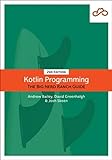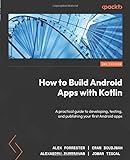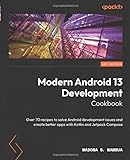Migrating Java code to Kotlin involves converting your existing Java codebase to Kotlin language syntax. This process can help improve code readability, reduce boilerplate code, and leverage Kotlin's features such as null safety, extension functions, and smart casts.
To migrate Java code to Kotlin, you can start by converting individual Java classes or files to Kotlin one at a time. You can use tools like the IntelliJ IDEA IDE, which provides built-in support for converting Java code to Kotlin. Additionally, you can use the Java to Kotlin converter tool provided by JetBrains to automate the conversion process for larger codebases.
When converting Java code to Kotlin, you will need to make adjustments to the syntax to align with Kotlin's language features. This includes changing variable declarations, method signatures, and other language constructs to Kotlin equivalents. You may also need to handle any Java-specific features that don't directly translate to Kotlin, such as static members or null handling.
It's important to test the migrated code thoroughly to ensure that it retains the same functionality as the original Java code. You can leverage Kotlin's interoperability with Java to gradually migrate your codebase, allowing both languages to coexist in the same project until you have fully transitioned to Kotlin.
Overall, migrating Java code to Kotlin can help modernize your codebase and take advantage of Kotlin's powerful language features for cleaner and more concise code.
How to handle libraries and dependencies when converting Java code to Kotlin?
When converting Java code to Kotlin, it is important to handle libraries and dependencies properly to ensure that the converted code works correctly. Here are some steps you can follow to handle libraries and dependencies:
- Update your build configuration: Update your build configuration file (such as build.gradle or build.gradle.kts) to include the necessary Kotlin dependencies. You can use the Kotlin Gradle plugin to automatically convert your Java code to Kotlin and add the necessary dependencies.
- Convert Java dependencies to Kotlin: Convert any Java dependencies in your project to their Kotlin equivalents. This may involve finding the Kotlin version of the library or using a different library altogether.
- Use the Kotlin standard library: Kotlin comes with its own standard library that provides many common functions and utilities. Replace any Java standard library calls with their Kotlin equivalents.
- Choose Kotlin-friendly libraries: When possible, choose libraries that are Kotlin-friendly and have good Kotlin support. This will make it easier to integrate them into your Kotlin code.
- Test your code: After converting your Java code to Kotlin and updating your dependencies, make sure to thoroughly test your code to ensure that it works correctly. Pay special attention to any areas where libraries or dependencies were changed.
By following these steps, you can successfully handle libraries and dependencies when converting Java code to Kotlin. This will help ensure that your code is well-organized, efficient, and maintainable in the long run.
How to handle method and class naming conventions when migrating Java code to Kotlin?
When migrating Java code to Kotlin, it is important to adhere to Kotlin's naming conventions to maintain consistency and readability in the code. Here are some guidelines on how to handle method and class naming conventions during the migration process:
- Class Names:
- Use PascalCase for class names in Kotlin, which means the first letter of each word in the class name is capitalized.
- If the class name is a single word, ensure that it is still capitalized.
Example:
Java: public class MyClassKotlin: class MyClass
- Method Names:
- Use camelCase for method names in Kotlin, which means the first letter of the method name is in lowercase and the first letter of each subsequent word is capitalized.
- If the method name is a single word, ensure that it is still in lowercase.
Example:
Java: public void myMethod()Kotlin: fun myMethod()
- Variable Names:
- Follow the same camelCase convention for variable names as for method names.
- Choose descriptive and meaningful variable names that indicate the purpose of the variable.
Example:
Java: int myVariable = 5;Kotlin: val myVariable = 5
- Constants:
- Use uppercase letters and underscores to separate words for constant names in Kotlin.
Example:
Java: public static final int MAX_SIZE = 100;Kotlin: const val MAX_SIZE = 100
By following these guidelines and adjusting the naming conventions accordingly, you can ensure that your migrated Java code maintains the readability and consistency expected in Kotlin code.
What are the key language differences between Java and Kotlin?
- Null Safety: Kotlin provides built-in null safety features, making the handling of null values more efficient and less error-prone compared to Java.
- Type Inference: Kotlin has a strong type inference system, allowing developers to write cleaner and more concise code by automatically inferring variable types. In Java, developers are required to explicitly declare variable types.
- Extension Functions: Kotlin allows developers to add new functions to existing classes without modifying their source code, a feature not available in Java.
- Immutability: In Kotlin, variables are by default immutable, meaning that once a value is assigned, it cannot be changed. In Java, variables are mutable by default.
- Smart Casts: Kotlin has smart casts, which allow developers to automatically cast types when certain conditions are met, reducing the need for manual type casting as seen in Java.
- Coroutines: Kotlin has built-in support for coroutines, allowing developers to write asynchronous code more easily and efficiently compared to Java's traditional threading model.
- Data Classes: Kotlin provides data classes, which automatically generate common utility methods such as equals(), hashCode(), and toString(), saving developers time and reducing boilerplate code.
- Operator Overloading: Kotlin allows developers to overload operators for custom types, providing more expressive code and reducing the need for verbose method calls. Java does not support operator overloading.
Overall, Kotlin offers a more modern and concise syntax, improved null safety, and additional language features compared to Java.









